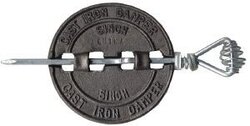Our first full season with the new Jotul Oslo is winding down, but not yet over. It is time to review some of my preconceptions and see how or if, they intersect with my experiences.
An enormous amount of research, thought, study, reading, and searching for advice went into the choice of our stove. In the end we went with the one the wife liked: Ivory enamel Jotul Oslo.
Frankly, I had my heart set on the Jotul 600 for our 2500 sq. ft. + house (not counting the 2000 sq. ft. basement). Even here in SW Missouri, where it seldom drops below 0 deg. f., it seemed like a more reasonable size for this large a house, even considering that it is very heavily insulated. But what finally made me see it her way (aside from wanting to continue to live here) was the realization that the extreme temperatures which would necessitate something the size of the Jotul 600 ocur only a few days each year, while the moderate temperatures (where a really large stove would be too much) stretch on for weeks and weeks.
And so it is. Here we are nearly at Easter and we have a nice fire running 350 deg. and keeping the house just warm enough. This seems to be fairly easy to do up to about 55 deg. f. ouside temperatures. Even when daytime temps run up into the 60's I can build one good fire in the evening, or sometimes just every other day, and the house will stay comfortable. It does not seem likely to me that the larger 600 would do this as easily, and maybe not at all: EPA stoves, particularly non-cat models, do not really like "small fires".
"But what about those 0 deg. nights?", you ask. As it turns out, the Oslo keep up quite easily, keeping the main part of the house at 68 deg. or better. It did take a while to "catch up" - about three hours, actually, when we were away all day, but the family room warms up quickly, so we were never uncomfortable.
I'm not going to claim all night burns, or even go to bat for Jotul's claim that it will burn eight hours. However, with practice I find I no longer have to load the stove in the middle of the night. A full load at 10:00 pm will leave a good pile of coals to light off the morning fire if I get around to it before 6:30 am or so.
The other leason was learned early on, and has appeared on these forums many times, but I don't think it can be repeated enough: the Oslo and other EPA non-cat stoves need dry wood. Think arid, dessicated, parched, sere. "This seems dry", isn't.
Mark
An enormous amount of research, thought, study, reading, and searching for advice went into the choice of our stove. In the end we went with the one the wife liked: Ivory enamel Jotul Oslo.
Frankly, I had my heart set on the Jotul 600 for our 2500 sq. ft. + house (not counting the 2000 sq. ft. basement). Even here in SW Missouri, where it seldom drops below 0 deg. f., it seemed like a more reasonable size for this large a house, even considering that it is very heavily insulated. But what finally made me see it her way (aside from wanting to continue to live here) was the realization that the extreme temperatures which would necessitate something the size of the Jotul 600 ocur only a few days each year, while the moderate temperatures (where a really large stove would be too much) stretch on for weeks and weeks.
And so it is. Here we are nearly at Easter and we have a nice fire running 350 deg. and keeping the house just warm enough. This seems to be fairly easy to do up to about 55 deg. f. ouside temperatures. Even when daytime temps run up into the 60's I can build one good fire in the evening, or sometimes just every other day, and the house will stay comfortable. It does not seem likely to me that the larger 600 would do this as easily, and maybe not at all: EPA stoves, particularly non-cat models, do not really like "small fires".
"But what about those 0 deg. nights?", you ask. As it turns out, the Oslo keep up quite easily, keeping the main part of the house at 68 deg. or better. It did take a while to "catch up" - about three hours, actually, when we were away all day, but the family room warms up quickly, so we were never uncomfortable.
I'm not going to claim all night burns, or even go to bat for Jotul's claim that it will burn eight hours. However, with practice I find I no longer have to load the stove in the middle of the night. A full load at 10:00 pm will leave a good pile of coals to light off the morning fire if I get around to it before 6:30 am or so.
The other leason was learned early on, and has appeared on these forums many times, but I don't think it can be repeated enough: the Oslo and other EPA non-cat stoves need dry wood. Think arid, dessicated, parched, sere. "This seems dry", isn't.
Mark



